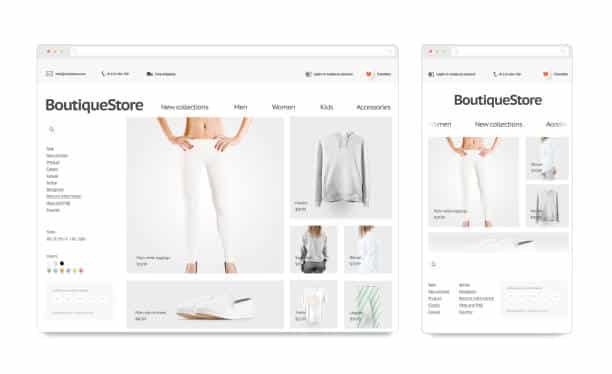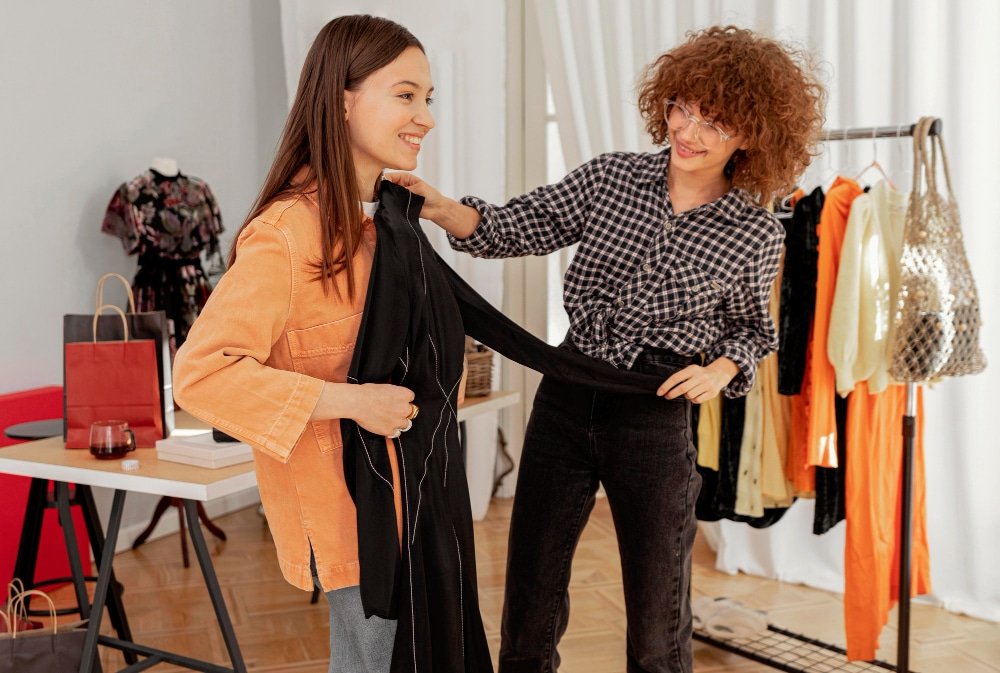Bring to light the mysteries of a successful brand launch from ready-to-market stage to company induction. Walk visitors through the 3 key processes such as going from the idea to your unique brand identity and marketing strategy and that will imprint success in your fashion business. Probe the in-depth details of product development, manufacturing, and distribution, thus, enabling you to manage the competitive environment successfully. Adopt our guidebook as its your road map towards realization of your dreams in the sea of fashion entrepreneurship.

Why Start a Clothing Business?
- Passion for Fashion: Many entrepreneurs in the fashion industry and if you have a passion for this industry, then you have a chance to start your own business. The beginning of the clothing business gives them the opportunity to convert their creativity into a livelihood.
- Expressing Creativity: The process of fashion design and the producing of clothes allows for the expression and display of the designer’s creativity. The creative side of entrepreneurs is not only about their designing and selling products they are also about expressing themselves and their view to the world.
- Meeting Consumer Needs: Clothes are the basic human need and there is always demand for new and stylish apparel. The launching of the clothing business by the entrepreneurs is aimed at filling up this need of the consumers and at giving them the choice of a perfect clothing that reflects their taste and way of life.
- Building a Brand: From the clothing industry, you can get an opportunity to build a branding and company identity of a strong one. The entrepreneurs can create a brand that will be appealing to their target audience and out of all competitors.
- Flexibility in Design: Launching a clothing brand grants entrepreneurs the chance to come up with a new and stylish trend or a gap to fill within the market through the drawing and creating comtstional items. They got an opportunity to be creative in design, fabric and the type of styles which can make a very attractive product for the buyers.
- Potential for High Profit Margins: Clothes have high profit margins, mainly for the premium and designer brands. High-performing products and good marketing strategies lead to attracting a large audience and hence, a high level of profit.
- Opportunity for Innovation: Designed, produced, and sold in a way that is constantly changing, the fashion industry is shaped by the trends cutting and the new technologies. Entrepreneurs may invent in the fields of sustainable fashion, wearable technology and personalized clothing.
- Diverse Market Segments: The apparel market is divided into a wide segmentation which includes men’s, women’s and kids clothing while the accessories also cut across these segments. This fringe provided a space for entrepreneurs to target niche areas or serve large market spaces.
- Global Reach: As e-commerce becomes a bigger thing, clothes businesses can now get to customers all over the world. The global reach enables the possibility of new market exploring and business expansion. Here the business gains traction beyond the local horizon.
- Personal Fulfillment: Unlike big brands or chains, the entrepreneur feels personally fulfilled as a result of creating a clothing business. It enables them to follow their dream, create something from scratch, and even to fashion industry.

Steps on How to Make a Clothing Brand
Define Your Niche
Decide on the group or the specialization in and type of the market in which you wish to create and sell your online clothing business or line. Have a look at nuances, check for target audience, and remember about the style and the price level of these products.
Conduct Market Research
Do the research about your target audience, your competitors and market trends. Analyze what gives your design the edge and how can solve the needs of your specified target population.
Create a Business Plan
Specify your business objectives, standard market, and product line, and marketing as well as financial plans. A well-constructed business plan will be your guidance for your clothing line’s success.
Develop Your Brand Identity
Identify the brand personality encompasses your values, mission statement, and your unique selling proposition. Your brand identity will be enticing to your niche consumers and should make your line stand out from competitors’ collections.
Design Your Clothing
Get in touch with fashion designers or come up with your own designs that suit your brand image and are appealing to your target audience. Account for elements, like the fashion designer name’s vibe, quality, and reasoning about your designs.
Source Materials and Suppliers
Research and build the fundaments of partnership with reliable suppliers among big amount of offerings of fabrics, trims, and other materials for production. Select suppliers that have the right raw materials at the most affordable retail price ever.

Create Prototypes and Samples
Make a successful version you can gather feedback from to show its quality, fit, and appeal. Add needed steps that should be performed before shifting into large-scale manufacturing.
Plan Production Process
As a responsible project manager, I will first be preparing the production programme, including the phases of manufacturing, the timelines, the quantities, and the logistical issues. Select suppliers that are capable of providing quality and production values that your brand satisfies.

Set Up Sales Channels
Decide the channels you will be sellingt your clothing line on, either through your own ecommerce website or online marketplaces, physical retail brick and mortar stores, or perhaps a combination of these. Manage the sales channels and make the purchasing process as smooth as possible for customers.
Brand and Packaging Design
Use designs for brand elements including logos, labels and packaging that transmit the branded image. Think of methods and ideas how your branding will affect the quality of the clothes in your fashion line.

Market and Promote Your Clothing Line
Formulate a marketing plan to be used in publicizing your clothing line and enticing consumers. Employ both online and offline marketing strategies including social media marketing, influencers association, social media advertising, email campaigns and offline events engagement.
Launch Your Clothing Line
Schedule a launch event or a marketing campaign to present your new clothing line to the market. Create a fuss and increase hype among customers to acquire audience and boost sales revenues.
Monitor and Adapt
Track the success of your clothing business by reading results like sales, customer reviews, and market tendencies. Ready to modify your marketing and sales strategy, and product offerings as the feedback and market changes come out.
Benefits of Starting a Clothing Brand

- Unleash Creativity: Clothing brand launching is an opportunity to share creative spirit in freedom. The process is highly conducive to sharp minds who initially conceive their vision and then carry that out with their styles by creating brand images, etc.
- Cultivate Brand Identity: The development of the clothing brand is a process that helps to create a unique identity that is recognizable to the people from the targeted group. With the application of clear-branded esthetic, you can build up emotional dependencies that in their turns will generate loyalty and distinguish your brand in a competitive environment.
- Embrace Entrepreneurial Spirit: Creating a brand of clothing means putting the entrepreneurial spirit into practice, which will be helpful in making decisions that are the most important in the business and overcoming difficulties. It is a voyage that is characterized by the adoption of new ideas, the endurance, and the desire for the growth.
- Financial Potential: An active clothing company is going to provide the necessary financial leverages that will result in lucrative profits ranging from renting space to stocking clothing material. With time your brand will gain traction and grow until it becomes highly profitable and the success of your project you can count on the revenue inflow increasing multiplefold.
- Influence and Impact: The clothing brands are the ones that influence beyond the fashion world. They are the ones who use their platform to advocate for different causes and to change the world. Alignment your brand to a cause or become a sustainability partner, it may leave your brand with a lasting impact on the society altogether.
- Forge Creative Collaborations: The collaboration between fashion industry and designers, artists and influencers is one of the main features of this business and the opening of doors to this close-knit circle of people is very much achievable. These collaborations are the ingredients that are going to make your brand’s story, spread it across the world, make it as innovative as possible.
- Flexibility and Autonomy: Being the owner of your clothing brand gives you a chance to multitask and enjoy a greater degree of freedom and self-determination. Starting with the sense of decision and independence, you can set-up your personal timetable, make the most strategic decisions, and even follow the path that corresponds to your goals.
- Global Reach: In the time of the digital age, the limits of trade are practically limitless. The e-commerce platforms as well as the social media give your brand a leverage to cross over the boundaries, enabling expansion to an international level, which in turn speeds up the growth.
- Personal Fulfillment: The remarkable pleasure of bringing your creative vision into a concrete fruitful result that wins the hearts of clients of your business is incomparable. Looking at the people who take your designs and are happy and derive the joy from it, it gives you a very deep sense of accomplishment.
- Legacy Building: Developing a successful brand in fashion is more than piggy-backing on the quick winnings; it is more of leaving a legacy that stays alive over time. You create evidence that leads to success on the long run which will leave you a lasting mark on the fashion trendscape.
How Much Does It Cost to Start your Own Clothing Line?

The cost of your own clothing line might start from very low to very high depending on many factors such as the scale of your operation, the quality of your clothing manufacturer, materials used, your production costs and methods, marketing efforts, and so on. Here’s a breakdown of potential expenses:
- Design and Development: Those include expenses that come as a result of developing the garment line, for example, hiring fashion designers, creating samples or purchasing inspirational materials. Whether you choose to break up the cost through monthly payments, pay in full, or borrow the complete amount, the cost may be between a few hundred dollars to a few thousand dollars.
- Materials and Production: The cost of materials and production will depend on several factors, like the amount of clothing produced, the level of designs’ complexity, and the quality of materials used. The costs associated with cloth, trims, labels and manufacturing charges should be factored in. This can range from just a couple thousand to tens of thousands, up to more, in terms of producing premium, or custom items.
- Branding and Marketing: The process of creating a brand identity and marketing your own clothing line is essential for the sake of attracting customers. Some of the expenses will be expenditures for designing logos and branding stuff, building the company website, taking pictures for product shots, Facebook ads optimization and others. These costs will be wide-ranging; however, they might be the beginning from a several hundred up to several thousand dollars monthly, subject to a size of your marketing.
- E-commerce Platform Fees: In case you want to advertise your clothing line through the internet, you will have to pay for the e-commerce platforms or website hosting fees. Plateforms such as Shopify or WooCommerce typically have a monthly subscription cost which is also added with a sales commission fee.
- Business Registration and Legal Fees: Paying for registering your business, taking the licenses, and trademarks or copyrights may make you delegate the money for them. The costs of these vehicles can be different, depending on your place of living and the legal regulations you have to obey.
- Inventory Management: One of the expenses you would have to cope with if you were to keep goods in your warehouse is the overhead of storing, managing, and shipping such products. One can do these by renting warehouse space, hiring employees, or outsourcing the job to a fulfillment service provider.
- Miscellaneous Expenses: There may be other incidental expenses you should think of, like office supplies and software subscriptions (for example, g. Although internet has reduced the need for commercial establishments, shopping malls have evolved into a unique social hub, where individuals can fulfill their aesthetic, social and emotional needs through activities like dining, window shopping, socializing, and service providers such as accountants or insurance firms. g. , accounting, legal).
It’s vital to meticulously budget and allocate the right amount to cover different expenses so you are fully able to start and successfully grow the brand name of your clothing line. Furthermore, think about starting with a small step and scaling up gradually as your brand story small business further grows to keep the initial costs low and the financial risks at bay.
Which Business Model Is Best for Starting an Online Clothing Store?
Dropshipping

One of the ways to implement a dropshipping model is to team up with the suppliers that will handle inventory storage, packing, and shipping of the products directly to the customers. You realize your products on the market, you collect back orders through your own online store and then submit them to the suppliers. This pattern eliminates the pre-season stores of goods through lower levels inventory financing cost, thus impose lower risk than traditional model. Nevertheless, you lose the power to guarantee the product’s quality, shipping time and profit margin.
Print-on-Demand (POD)

Using on-demand print services, you can make your own custom-made clothing and utilize designs of your choice. g. , etc) with the designs printed on different kinds of clothes whenever a new order is submitted. You will put your designs on a POD platform and they will be responsible for production, fulfillment and shipping. Such model is characterized by the absence of inventory which improves product selection and allows customization of the same product lines. Nevertheless, earning potential and business models may be affected because raw materials might cost significantly higher.
Traditional E-commerce

In a classical e-commerce model, you buy the inventory in advance, store the purchase in a warehouse, and then fulfil the orders directly to the customers. Thus, this model allows you to exert a tighter grip on quality of products, brand and customer experience. Although it will involve greater initial investment of resources for stocks and space for storage, it has the potential of a higher profit margin and freedom to exercise the aforementioned factor.
How to Market Your Clothing Brand
The way you market your clothing brand will decide the success of your own fashion brand, in terms of brand awareness, customers, and sales. Here are some strategies to consider:
- Define Your Brand Identity: First, you need to form a distinct brand personality that not only reflects the essence of your brand but also its values, as well as your customers’ demographic. This will tell us what the customer wants to know and convince all your marketing affairs to be in the line of the customers’ thinking by keeping consistent messaging and visuals.
- Create Compelling Visual Content: Hire professional photographers and graphic designers to create the best selling points on your clothing line. With image and videos playing a vital role, feature your must-have items, lifestyle shots, and backstage snippets that are likely to appeal your audience.
- Build a Strong Online Presence: Launch an appropriately designed professional website for your clothing brand that can be effectively accessed from desktop computers, mobile devices or tablets. Social media platforms such as Instagram, Facebook, Pinterest, and TikTok can be very helpful in engaging with your audience, sharing visual content, and driving traffic to your website.
- Develop a Content Marketing Strategy: You can produce an insightful and engaging content that will stick out between the row of same stuff by your target audience. It might concern blog posts, style guide, fashion advice and even the user-generated content as well as your products. Concentrate on the value that you can bring and the rapport that you can create with your audience instead of just pushing the products.
- Utilize Influencer Marketing: Partner with fashion bloggers and fashion influencers who reflect yours brand’ aesthetic and virtues. Work with them on sponsored content, product reviews, and influencer takeovers for spreading the message and considering their reputation, credibility and following.
- Implement Email Marketing: Create an email list of subscribers who are interested in your clothing brand and send them regular updates, promotions, and exclusive offers regularly. Individualize your emails by using customers’ interests and activities to maximize traffic and ROI.
- Optimize for Search Engines (SEO): Make sure you design your website with SEO in mind and your content is SEO friendly for a higher probability of appearing in natural search results. Apply relevant keywords, meta tags, and descriptive product descriptions to your website in order to attract the organic traffic.
- Offer Promotions and Discounts: Provide promotions, discounts, and sales as well as limited- time offerings to cheapen customers’ purchase decisions. For example, the discounts during the first purchase, scheme for referral and loyalty programs for the long-term clients are possible ways to increase the number of repeat purchases.
- Attend Fashion Events and Trade Shows: Go to fashion events, trade shows, pop-up shops, and markets to display your clothing line, meet with industry experts, and connect with potential clients in person.
- Collect and Showcase Customer Reviews: Promote happy customers with the testimonials and descriptions of their experience with your clothing brand. Public these reviews in a visible manner on your website and social platforms to create trust and unbiased opinions towards potential consumers.

Through continuous application of these marketing strategies and their adjustment to your own clothing brand’s specific needs and goals, you will be able to effectively advertise your clothing brand and gain a loyal customer base.
How to Introduce/Advertise Products of your Clothing Business?
Define Your Target Audience

Before you start to introduce your products, it is vital to know your target audience and their tastes. Considering demographics, lifestyles, tastes and purchasing behaviors, it is feasible tailor the strategy of product introduction as per the individual selling mission.
Create Compelling Product Descriptions
Compose concise and precise appealing product descriptions which emphasize the functions, perks, and the main selling points of the offered clothing items. Choose the language that is descriptive, imagine and tell stories to make the reader feel.
Professional Photography and Visuals

Invest in a high-level shoot with quality photography and visual content to position your clothing products in a much better light. Use of professional models, styling, and lighting techniques will create attractive and interesting visuals that will appeal to your target audience and clearly show the brand vibe that you want.
Launch Campaigns and Events
Come up with and implement a release campaign and the events to present your clothes to your target audience. Think of a reflecting launching party or a fashion show to to start a clothing line. Such events may be prequel or pop-up events.
Utilize Social Media

Harness the power of Instagram, Facebook, Pinterest and even the TikTok community in displaying of your fashion products to the global outlay. Make your content visually appealing, including photos, videos, and stories, so that your followers can be engaged and be motivated to further explore your products.
Collaborate with Influencers
Work with unions, fashion bloggers, social media content makers, and people who share style similarities with your target customers and brand image. Sponsor content, review new products, run influencer marketing campaigns with them so as to tap their reach and credibility and let followers explore your brand and your fashion clothes on social media sites.
Offer Exclusive Promotions

Establish one-of-a-kind promotions, discounts, or early access to your clothing products to arouse the customers to test your items. Time-limited offers such as flash sales and special deals play on the emotions, spurring customers on to buy as they try to maximize the value of their purchase.
Engage with Your Audience

Be more interactive with your followers across social media, email, and other platforms that can increase the strong connection with your brand among customers and create a better engagement of fans with your brand. Its important to respond to comments, messages and inquiries immediately and also to encourage user-generated content which will display real customers wearing your clothing products.
Collect and Showcase Customer Reviews
Encourage your product customers to share their experience stories involving your clothes brand on forum and review websites. Put these reviews on your website and social media channels in a prominent manner to make people trust and believe you and to show that your product is really good and that your customers are satisfied.
Monitor and Evaluate Performance
Monitoring the impact of your product introduction efforts is best done using feedback from your customers and analytics tools such as website traffic, social media engagement, conversion rates, and sales. Analyze the effectiveness of marketing methods that you suggest and revise them if necessary to bring about a fruitful release of your product and keep its performance at a high level.
How much Revenue Does a Clothing Brand Make?

The income of a clothing brand is determined by a number of factors, such as brand reputation, target market, product pricing, marketing strategies, distribution channels and overall business efficiency. Motivated brands with a well engraved market presence always create millions and billions of dollars however; the reputation of the firm is the decisive advantage that commands for premium prices. On the other hand, small brands or new brands could generate a lower amount of income but could win higher market shares aiming to reach higher sale volumes, which would be in balance with the lower profit margins. Luxury brands specialize in small markets and rely on exclusivity to make their products sell. On the other hand, mass-market brands focus on being affordable and accessible to a large number of people. To have profits buying famous and successful fashion brand it is sometimes subject to external factors such as customers’ fashion, economic situation and competitive pressure. This demonstrates the significance of management adaptation and continuous supply of fresh ideas to maintain surge. Beside all, the income of the clothing business will depend on how the brand will be able to satisfy consumer demand, offer due value, and build brand loyalty in the dynamically white-hot market we deal with all the time.
Pros and Cons of Making your Own Clothing line business?

Pros
- Creative Expression: The creation of your own clothing line helps you to showcase your creativity and fashion design sense, making your idea come true through clothing.
- Entrepreneurial Opportunity: Creating a clothing line is a business venture which allows you to be self-employed and operate by your own rules. Furthermore, you can develop an enterprise from its foundation till it becomes stable.
- Brand Building: Creating a clothing brand lets you build a special identity through which you can relate to your potential customers, and more importantly allow both sides to appreciate the uniqueness of your products and services over time.
- Potential for Profit: A successful clothing line would have a great profit and it can be more if you can identify and meet the needs of your target market effectively.
- Flexibility and Control: Besides running your own clothing line you get a chance to set up your own path in multiple aspects such as design products, pricing, marketing, and a manner of business management that can be changed to suit your own needs at any given point in time.
- Impact and Influence: Clothes labels may be able to change the life of the world and start the fashion movement by eco-friendliness, the existence or not of racism, or stimulating in another area..
Cons
- High Competition: The fashion industry is really competitive with many established brands and other new entrants all fighting for their market share. It can be hard to break through the noise of a competitive market which is where standing out is very challenging.
- Financial Risk: Starting a collection with clothing will bring immense time, money and resources, meanwhile the risk of failure cannot be denied. Financial risk is an inescapable part of any business and there are chances of losses if the business does not perform as expected.
- Complex Supply Chain: Managing the supply chain of a clothing brand is a challenging task, being the coordination of materials, production, distribution of stocks and logistics. Facing of suppliers, manufacturers and wholesalers the business will suffer from extra amount of mess.
- Seasonal and Trend-driven: The fashion industry is inherently seasonal and trend-oriented, with consumer preferences and demand constantly varying. To be able to keep pace with the trends and crate up your product offering to fit in them, you will have to work constantly vigilantly.
- Marketing and Promotion: Pioneering and cultivating your clothing business takes a lot of time, energy, analyzing and combining different channels and marketing strategies. The process of creating brand awareness and customer acquisition can be expensive and time-consuming.
- Production Challenges: Production entitles difficulties as the quality control, sizing inaccuracies, and delays can occur at this time. Production might be difficult to manage, and this could be mixed with the work of ensuring the quality of the products when one is venturing into entrepreneurship for the first time.
What are the Latest Fashion Brands Trend for Clothing Businesses
The world of fashion is constantly being reshaped by a number of aspects such as culture, the ever changing technology, the environment, and social movements. Because by the time of my last referring to the January of 2022, the fashion industry was being shaped by some trends. Here are some of the latest fashion brand trends for clothing manufacturers and businesses:

- Sustainability and Ethical Practices: Sustainability remained to be one of the key issues for fashion brands, and more and more customers started to ask for products that are friendly to the environment and are produced in a sustainable and ethical way. Enterprises like STELLA McCARTNEY, REFORMATION and EILEEN FISHER for instance come into the limelight with their ultimate product sustainability throughout the supply chain.
- Gender-Inclusive Fashion: Trend of the gender-neutral and gender-inclusive clothing lines was the result which offered an opportunity to take a recourse against the customary views of masculinity and femininity Companies like Phlemuns, Telfar, and Thom Browne took the concept of unisex fashion to the next level, blurring the line between menswear and womenswear and offering designs that could be worn by all genders.
- Digital and NFT Fashion: The advent of digital fashion and non-fungible tokens (NFTs) have created avenues in the fashion world that were earlier unexplored with huge potential for creation and expressiveness. Companies such as The Fabricant and RTFKT Studio engaged in new dimension of fashion – digital fashion, manufacturing digital clothes and accessories that were distributed and traded as the NFTs.
- Tech-Driven Apparel: Technology proved to be another crucial player in fashion, with brands adding tech elements into their clothing designs. Examples given here are smart textile devices for health monitoring, smart fabrics which can regulate the temperature and virtual try-ons where use AR/VR.
- Community-Centric Brands: Brands that continued to nurture strong communities and created a dialogue with their patrons about social issues were the ones that held the market. Patagonia, Everlane, and Allbirds brands were the ones who put transparency, activism, and community-building in the core of their mission and marketing.
- Athleisure and Comfort Wear: The COVID-19 situation turned the game and made it possible for comfortable and functional clothing to become even more of a part of our everyday attire and athletic wear to be the main clothing styles. Legacy brands akin to Lululemon, Athleta, and Outdoor Voices really nailed the market trend and filled the demand by introducing multifunctional activewear that can be your reliable companion right to your home to gym or to the office.
- Upcycling and Circular Fashion: Upcycling and circular fashion become the trend as brands are trying to decrease the amount of waste and the impact on the environment. Examples of brands that have adapted upcycled materials and circular designs include Marine Serre, Rave Review, and Chrisopher Raeburn.
- Streetwear and Luxury Collabs: It is worth mentioning that streetwear brands allied themselves with luxury fashion houses still stirred up that much-needed buzz. Popular brands such as Nike, Adidas, and Louis Vuitton joined hands with streetwear icons like Off-White, Yeezy, and Supreme to create exclusive collections that merged streetwear and high fashion.
This was probably some of the latest fashions of that era, which only top brands could provide an edge during that competitive time. I would like to inform you that fashion movements are always new. New fashion styles may appear when a society changes its approach toward gender differentiation and in the case a new fashion wave emerges because of population choices. Proving the point of keeping a tack with the latest fashion trends and consumer behaviors is a critical part of the clothing business to keep on the pace and be the best in the ever-changing fashion world.
Does LLC a Requirement to Start a Clothing brand?

Forming a limited liability company (LLC) is not a strict requirement to even start selling a clothing brand, but it’s often recommended for several reasons:Forming a limited liability company (LLC) is not a strict requirement to even start selling a clothing brand, but it’s often recommended for several reasons:
- Limited Liability Protection: In particular, creating an LLC ensures that members, who make up the LLC, possess a limited liability protection. In other words, the individual assets of the participants are usually protected from the debts and liabilities of the business. If a company that a sworn member participates in has a legal problem or financial obligation ,his/her personal assets which included home and savings would in most cases be defended.
- Professionalism and Credibility: Being an LLC has a number of benefits, the biggest one being the level of credibility and professionalism it gives you, which may come in handy when dealing with suppliers, manufacturers, retailers and customers. It also shows to the stakeholders that you are not just playing around but earnestly pursuing your business and are determined to run it in a systematic and organized way.
- Separation of Personal and Business Finances: Deducting LLC is a good technique on you ground soil life to your private spending with business finances. Such separation is necessary to ensure no mistakes, to be on track with the accounting records, to control the fund inflow and taxes. It also makes accounting more straightforward and reduces the risk of mixing of funds, which could compromise limited liability protection.
- Tax Flexibility: The flexibility that LLCs have got in taxing aspects is incomparable which makes them one of the most preferred business structures. Built-in LLCs enjoy a tax advantage of pass-through entities, that means the profits and losses are passed through to their members’ returns. Nonetheless, LLCs can opt for a corporate taxation, called S Corporation or C Corporation status, which may be a good choice in some cases in terms of tax advantages depending on your business structure and financial objectives.
Setting up an LLC is not necessary nor sufficient for putting into business a clothing line or brand. This is only for some of the reasons mentioned. While creating an LLC is certainly a viable option, it is important to keep in mind the various aspects that are unique to you and your business objectives in order to make an informed decision about the structure of your entity, including your risk tolerance, legal concerns, and long-term plans. It is highly recommended that you seek the advice of both the legal and the financial experts in order to find out the best business structure for your small clothing line or brand.
Conclusion
Starting up a fashion label is much more complicated. It is composed of a few aspects including a design, the manufacturing of the product, promoting it, and distribution. The task of achieving success depends on a combination of innovation, market research, strategic plan, and performing. Through a well-thought-out design of your brand identity, figuring out your target audience, and developing the best marketing strategies, you can create a distinct position in the very competitive fashion industry arena. By adapting to innovation, therefore standing on top of the consumers needs, and of course nurturing the real connections with your consumers are vital for viability and auditability. In the end launching a clothing line online is no longer only a business of the selling garments; it is also a storytelling platform, a space for spicing up the experiences and a community around the brand. Through hard work, determination, and a great enterprising spirit, you can turn your idea into a successful business in the hot world of fashion.

